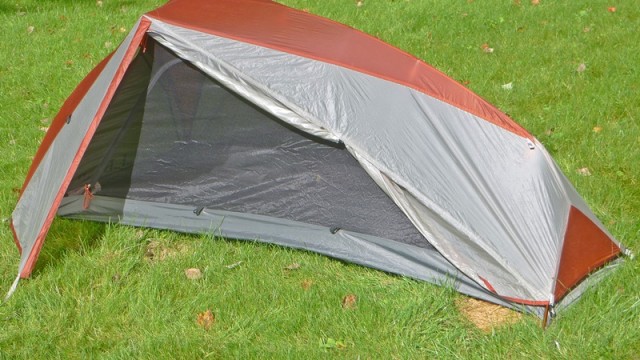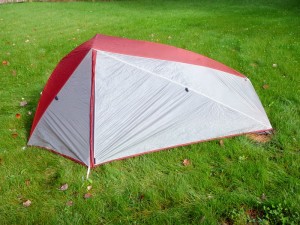
UPDATE: The Microlight FS tent has been replaced by the Microlight UL. An updated, lighter version, it has the same design and features as the original in this article. Read on to learn about the tent, and then see our comments at the end of the article for details on the update.
When we tested a range of 1 person tents a few years ago, L.L. Bean’s offering was a front entry non-freestanding tent with a bargain basement price. For the money, it was a lot of tent…but ultimately, our review came down to one thing: It was CHEAP. And while front entry tents have certain advantages when it comes to pitching them in tight timber, we ultimately find that for most users, the tradeoffs of easier entry/exit and more functional vestibules in side entry tents make them a better choice.
With the introduction of the L.L. Bean Microlight FS 1-Person Tent, it appeared that the designers there came to that same conclusion. Gone is the front entry; also gone is the somewhat bulky packed shape. Gone, also, is a bit of weight (our sample came in at 3 lbs 4 oz vs. the previous 3 lbs 8 oz); that with noticeably larger interior dimensions. And, no surprise, gone is the bargain-basement price. At $199 retail, the Microlight is still near the bottom of the range, but no longer has the “are they kidding me?” price. Given the usual cost of lowering weight, the increase is pretty reasonable, but is the tent actually better?
The answer is an unequivocal yes. Testers of the previous version found lots of little irritations; virtually every comment had a variation on “but for the price” in it. This time around, the typical comment started with something along the lines of “Really nice tent.” Perfect? No. Better, and able to be compared to best-of-class? Yes, and that’s a huge improvement.
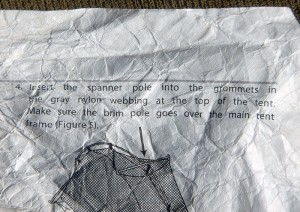
So, let’s look at details. Materials are solid, with the tent body & fly being light but still durable. Setup is ridiculously easy, with a single hubbed pole that is utterly intuitive…wide end goes at the head, narrow end at the feet, duh. Not quite as intiutive, though, is the short spanner or spreader pole that goes across the top of the tent. We’re embarassed to say that the first couple of testers didn’t read the instructions and ran it under the main pole; it worked, but it caused the rain fly to flap. Once we figured that problem out, though, setup was obvious and quick. And, the result is a well laid out, roomy tent with plenty of room for 6+ footers while lying down (they mussed up their hair when they sat up, though; overhead height is good, but not stratospheric). Two quibbles; the first is the choice of a drop down door. When rolled up and secured, it stayed out of the way, but in the middle of the night it was easy to trip over it, particularly if we didn’t open the door fully. Next generation, we’d love to see that shift to rolling up or to the side. The other is a lack of storage space inside. There’s only one very small mesh pocket; it’ll hold your headlamp, but if you’re getting older like many of us, it’ll barely hold your headlamp AND reading glasses. We’d love to see at least enough space for those and a book or Kindle; keeping those off the floor where it can be damp is a wonderful thing.
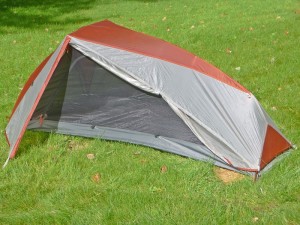
But, quibbles those are. Night after night, we slept comfy, without any feeling of claustrophobia. The design put the lantern loop in exactly the right place, too; with some of the new LED lanterns we’re playing with (like the UCO Clarus), we didn’t even need a headlamp to read. Ventilation was very good, and with the fly staked out well, there wasn’t generally much contact to allow condensation back in. At the same time, the tent hunkered down well in lousy weather, surviving high winds with little movement. Putting the fly on is as easy as setting up the tent itself; the Velcro attachments come well between tent attachment points on the poles, so there’s no fiddling around after because you hooked it up on the wrong side. As much as we love trick connections like DAC’s Jake’s Foot, the Microlight uses a very simple pole end and grommet setup that is impossible to mess up, with both the tent and fly attaching to the same spot. Duh. With the fly correctly set up, we never had problems with rain blowing in during the night.
Vestibule space is somewhat of a mixed bag, though. On the positive side, the rainfly comes far enough out on the back side (non-door) of the tent that there’s room to throw some items in there; you’ll want to, as the layout of the main vestibule doesn’t leave a lot of room to put larger items (like your pack) without you either tripping over them when you exit, or them getting soaked every time you open the fly in the rain. The Microlight isn’t the only tent that has this problem; it’s pretty common with solo tents given their tight dimensions. The good news is that you aren’t likely to have a huge pack or amount of gear when you’re using this tent, so you’ll be able to find homes for it all.
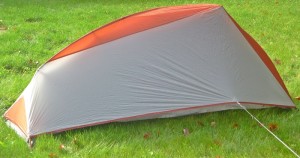
Ultimately, it comes down to the way testers viewed the L.L Bean Microlight FS 1-Person tent vs. the previous generation. The “but it’s CHEAP” comment has been replaced by “really, that’s all it costs?” Where the past generation was defined only by being a bargain, this is defined by being a very good tent AND a bargain. The combination of size, weight, ease of setup, and durability provide a pretty strong argument for anyone to buy it; add in the price (and L.L. Bean’s iron-clad warranty), and you’ve got a value proposition that will likely to propel it to the front of the line for shoppers without unlimited funds.
Update time. The Microlight UL 1-Person Backpacking Tent has the same dimensions, hubbed pole setup, and features as the original we wrote about here. So, whats’s changed? Two things, materials and price. First, materials…Bean has gone to much lighter products throughout. How much lighter? The new tent weighs in at 2 pounds, 4 ounces, or exactly 1 POUND lighter than the original. That’s huge, obviously. As expected, price has gone the opposite direction, from $199 to $299. Is it worth it? Well, weight is now among the class leaders, and so is the price. We can’t call it a bargain anymore, but it’s worthy of being considered with the best, and DOES have that famous LL Bean warranty. We’d certainly recommend looking at it long and hard before making a decision about which ultralight 1-person tent to buy.


